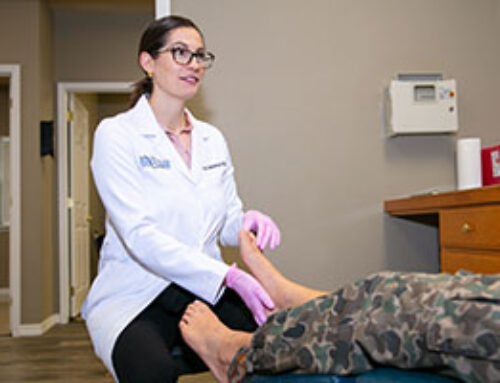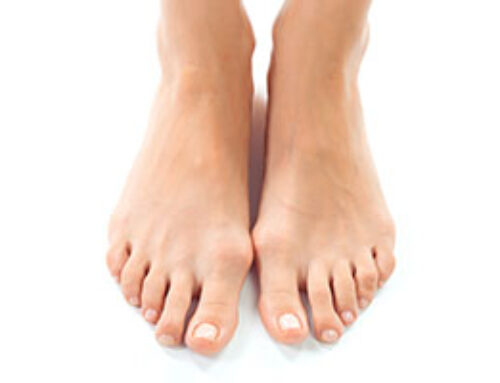Arthritis is a leading cause of disability in the United States that affects 24 percent of adults. In fact, more than 58.5 million Americans have arthritis. The term is a combination of two Greek words: “arthro,” which means joint, and “-itis,” which means inflammation. Inflammation of the joints is what all types of arthritis have in common.
When arthritis affects the feet, every step you take can be excruciating. If arthritis makes walking painful, you may find yourself making posture adjustments that have adverse effects throughout the body.
The foot contains more than 30 joints, so if you have arthritis, you probably feel the painful effects in your feet. Symptoms of arthritis include:
- Joints that are tender and warm to the touch
- Stiffness and pain that makes movement difficult
- Limited motion
- Loss of joint function
In addition to limiting your ability to perform everyday tasks, like climbing stairs, arthritis can cause permanent damage to your joints and other parts of your body. That’s why it’s crucial to address arthritis as soon as you experience symptoms.
Facts about arthritis
Anyone, at any age, can get arthritis. While the risk of developing certain types of arthritis increases as we get older, there is no link between arthritis and age. More than 300,000 children in the United States have arthritis, while some seniors never develop symptoms.
Some may believe that exercise wears joints down, so it’s important to avoid physical activity. However, a sedentary lifestyle only makes most types of arthritis worse. Staying active can strengthen your muscles and keep your joints flexible.
Another common myth, that cracking your knuckles can cause arthritis, is patently false. In addition, arthritis isn’t a condition you simply need to live with. In fact, a wide range of treatments are available to treat and alleviate the symptoms of arthritis.
Different types of arthritis that affect the feet
Arthritis is not a single disease, but a description of many different conditions. Each has its own causes and symptoms, and some forms of arthritis may coexist with another. Forms of arthritis include:
Osteoarthritis
Osteoarthritis is the most common type of arthritis. It can be thought of as simple wear and tear that happens to the joints over time. Years of walking, running, jumping, and bearing weight gradually wear down the cartilage in the joints. Cartilage is the soft, flexible tissue in the joints that serves as a cushion. When the cartilage is damaged, the joints lose much of their cushion, and simple movement becomes painful. Symptoms usually start around age 50.
Osteoarthritis is most common in the hands, knees, hips, and lower back, but it can affect any joint in the body. In the feet, osteoarthritis is usually found in the heelbone, the joint between the foot and the big toe, and the joint that connects the ankle and shinbone.
Post-traumatic arthritis
Post-traumatic arthritis is often temporary, and many people recover in a few months. Like osteoarthritis, it describes damage to the cartilage between the joints, but post-traumatic arthritis is different in that it results from a physical injury. In rare cases, the joint may never fully heal, and cartilage may never fully grow back. Other times, symptoms don’t emerge for years.
Gout
Gout is a common form of arthritis that most often affects the big toe. It results from a build up of uric acid in the body called hyperuricemia. Your body extracts uric acid from purines, which are found in a variety of foods, including red meat, alcohol, sweetened beverages, and most foods heavy in fat.
Purines are healthy in appropriate amounts, but when excess uric acid builds up in the bloodstream, urate crystals can form in your joints and cause gout attacks. These can come on suddenly and be severe. Symptoms include swelling, tenderness, and a painful burning sensation. Even the slightest touch may be unbearable.
Eating a low-purine diet can help prevent gout and improve your overall health and well-being.
Rheumatoid arthritis (RA)
Rheumatoid arthritis is a chronic inflammatory disorder that affects the lining of the joints and causes painful swelling. As an autoimmune disorder that occurs when your immune system mistakenly attacks the tissues of your body, the condition causes the joints to swell and become inflamed, which can eventually result in bone erosion.
As rheumatoid arthritis progresses, simple tasks like walking can become extremely painful. The condition is especially serious because it can also attack other parts of the body, including the lungs, eyes, kidneys, and skin, and result in physical disabilities
Ways to manage arthritis
Making healthy lifestyle changes to reduce the symptoms of arthritis can help you find relief so you can pursue activities that are important to you.
- Maintain a healthy weight. An extra pound of body weight puts about five extra pounds of force on your feet. Excess weight can also increase inflammation, which is a common symptom of rheumatoid arthritis. The best way to lose weight is to control your diet and stay physically active.
- Stay active. It can be difficult to get regular exercise when you have joint pain, but moderate physical activity can help maintain joint function, reduce pain, and relieve stiffness. You don’t need to join a gym to get the exercise you need. Any movement counts, including gardening and cleaning the house.
- Quit smoking. Rheumatoid arthritis (RA) and smoking can both cause inflammation in the body, a common symptom of arthritis. The link between smoking and rheumatoid arthritis is complex as not all smokers develop RA, and not all people with RA use tobacco. However, smoking also increases the risk of cancer, stroke, diabetes, and cardiovascular disease, so ask your doctor about steps you can take to quit the habit for good.
Arthritis exercises
In addition to helping with weight loss, exercise strengthens your muscles and reduces the chance of your joints becoming overloaded. If you haven’t been physically active recently or are recovering from an injury, ask your doctor to recommend exercises that are right for you. Chair exercises for arthritis are an option for those with limited mobility.
A simple way to start is to walk for 30 minutes a day. When walking, be careful to stay on flat terrain as much as possible. The more you walk, the more you may find yourself wanting to exercise. Next steps may include running, swimming, riding a bicycle, or strength training.
How to treat arthritis
Treatments for arthritis depend on the type of arthritis you have and the gravity of your symptoms. While there is no cure for arthritis, following a few general principles can help ease the pain, stiffness, and swelling you experience on a daily basis.
- The goal of physical therapy is to increase the range of motion and flexibility of your joints and strengthen the muscles in your foot and ankle. However, in some cases it may intensify arthritic joint pain.
- Your doctor may recommend you wear shoes with thicker soles or prescribe custom orthotics that can help correct misalignments and take pressure off joints that cause pain.
- Cold temperatures can cause swelling in the joints, aggravating symptoms of conditions like osteoarthritis. This is one reason why winters can be especially hard on those who suffer from the condition. To minimize the affect of cold temperatures, wear warm clothing in layers.
- Depending on the type of pain you have, you may want to consider using a hot or cold therapy. While cold therapy reduces swelling and inflammation by decreasing blood flow to the joints, heat therapy reduces joint stiffness by loosening the muscles.
- Take a non-steroidal anti-inflammatory drug (NSAID), such as aspirin, ibuprofen, or naproxen to reduce the pain and swelling associated with arthritis. Before taking an NSAID, talk to your doctor about the potential cardiovascular and GI complications these drugs may pose.
- If over-the-counter medications don’t work, you can have steroids, such as cortisone, injected into the joint. These substances act like artificial joint fluid and provide temporary cushioning.
- As arthritis of the foot progresses, your doctor may recommend that you use an assistive device, such as a brace or a cane, to relieve joint pain. In some cases, your doctor may recommend surgical treatment for foot arthritis, such as arthroscopic surgery, fusion, or ankle replacement.
Take your symptoms seriously, even if they are mild. Catching arthritis early can help your doctor address the root causes and slow or limit the progression of the condition.
Metro Tulsa Foot & Ankle Specialists is here to help you find out what’s causing your arthritis and begin treatment before things get worse. Schedule an appointment with us today.
Subscribe to stay up-to-date on news and tips from us.




